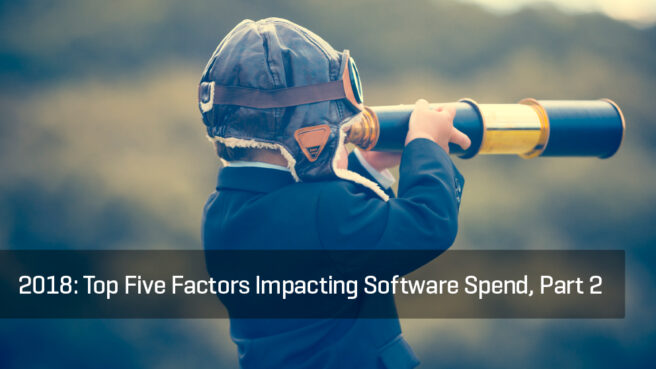2018: Top Five Factors Impacting Software Spend – Part II

The tech industry is one of the most stimulating and challenging and new opportunities arise continually. To help navigate the waters, I have gathered five insights, which I believe will impact IT spend in 2018. You can read about the first three – the GDPR, forecast for multi-cloud, and IoT maturity – in part 1. In this second part, I take a look at the benefits of data and analytics, and how openness fuels decentralization.
The benefits of data – actionable intelligence – are perhaps obvious. Insight into processes like sales, HR, and finance not only enables a business to improve cost and resource estimates, it enables bottlenecks and shortcuts to be identified. Insight removes guesswork and gut-feelings from the decision-making process, it enables improvements to be measured, and opens new – potentially unrelated – business lines.
Services based on community-sourced data, like Waze and Moovit, are popular consumer-facing applications whose value rises as users opt-in. The community-sourced approach has spread to B2B, giving rise to intelligence services driven by shared data. In the case of Waze, the accuracy of traffic reports rises as users become more active. Similarly, shared business intelligence can provide enterprises within a given domain actionable intelligence that isn’t available through other methods. Snow’s Software Recognition Service , for example, works in this way – as soon as a new application is recognized, all our customers benefit from the intelligence. In the coming year, I anticipate a spread of community-sourced applications within industry.
The other side of the data-driven industry is an increased reliance on big-data technologies, AI, analytics, and machine learning to extract intelligence from corporate networks as the amount of data available rises exponentially. What I hear from our customers, for example, is the need to examine what-if scenarios. What, for example, are the risks in terms of cost and licensing of moving a datacenter running Oracle software from one environment to another? What these customers need is a digital twin – a digital representation of a real-world entity or system. – named by Gartner as one of the top strategic technology trends for 2018. Customers want to be able to simulate business decisions, with multiple possible outcomes, and be able to analyze the results before any real-life decisions are made.
The GDPR reflects the need to protect individuals against abuse of personal data. It puts the individual in charge. As technology innovation relies on data-driven approaches, controls need to be in place to protect individuals and their data, while at the same time facilitating the technological advancements that depend on that data.
The exposure of the Panama and Paradise papers, and the recent publication of 17 blacklisted countries by the EU reflects a rising lack of tolerance in society regarding corruption, excessive control, tax planning, and a shift toward principles based on equality of economic, social, and civil rights. It reflects a desire for the openness that technology innovation thrives on.
The adoption of BYOD in the corporate world, is just one of the changes that reflects the shift toward openness and freer ways of working. That software and hardware vendors are shifting to support the BYOD model and its many variants is a definitive shift away from centralized enterprise IT.
Blockchain is another example of how the pendulum is swinging in favor of decentralization causing disruption. And in 2018, I think decentralization and the resulting disruption, particularly in enterprise IT will continue to rise. I don’t think the time is yet ripe for disruptive sources like cryptocurrencies, for example, to decentralize banking systems in favor of a balanced, less avaricious system. I am talking about an evolution of the current state.
CONCLUSION
The GDPR confirms the need for protection of the individual as data storage and processing capabilities become commoditized, and digitalization deepens – empowering people to remain in control of their digital identities. The GDPR reflects ongoing decentralization, as the powerhouses of the twentieth century struggle, becoming replaced by e-commerce, freelance networks, and community-sourced niche solutions.
It’s all about the data. Regulations are changing to protect it, technology is evolving to depend on it, and its creation is shifting from the establishment to the individual.
For IT, decentralization and disruption will continue. But consolidation will occur in risk, with solutions like Snow providing a homogenous view of the corporate network feeding in to multiple business disciplines.
Openness and decentralization has given rise to concern over the development of new monolithic powerhouses, but if the world remains at peace, I believe that the momentum of current disruption will ensure that individual empowerment will prevail as we look beyond 2020.
If you are looking for solutions to help you with managing cloud, ensuring GDPR compliance, or providing greater insight into your IT estate, sign up for a Play-in-the-Snow event near you, where you can see our solutions in action and get answers to your questions – check out our events page.